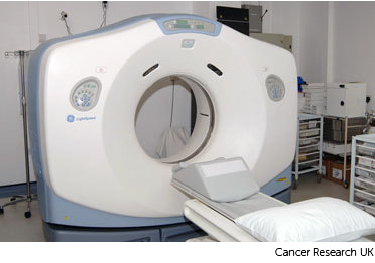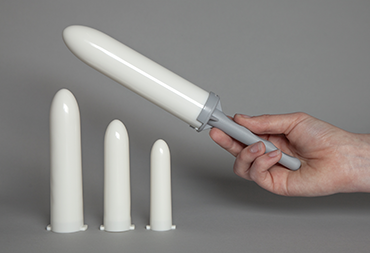Internal radiotherapy for vaginal cancer
Internal radiotherapy means giving radiotherapy to the cancer from inside the body. It is also called brachytherapy.
Radiotherapy uses high energy x-rays to kill cancer cells.
Having internal radiotherapy
To have internal radiotherapy, you need to have an applicator or implant inserted into the vagina. A radioactive source is then placed inside the applicator or implant. The treatment gives a high dose of radiation to the cancer but very little to the surrounding tissues.
Internal radiotherapy can shrink the cancer, relieve symptoms and help you feel more comfortable.
You might have treatment in the radiotherapy department as an outpatient or you might stay in hospital. This depends on the type of treatment you have.
You usually have internal radiotherapy to give an extra dose of radiation after external radiotherapy. In some situations, you might have internal radiotherapy on its own, but this is not very common.
Types of internal radiotherapy
There are 2 main types of internal radiotherapy for vaginal cancer. These are:
- Intracavity radiotherapy
- Interstitial radiotherapy
Intracavity radiotherapy
You have a tube called an applicator placed inside the vagina. The treatment is given by a special brachytherapy machine which is kept in a special room.
The machine contains a small radioactive pellet that leaves the machine and enters the tube. Once inside it releases radiation. You won’t feel the radiotherapy, but the tube can feel uncomfortable.
The applicator is only put in place for the treatment. Your doctor or radiographer takes the applicator out when the treatment finishes.
You may have this treatment following a course of external radiotherapy. People with early stage vaginal cancer might have intracavity treatment only.
Interstitial radiotherapy
For this type of internal radiotherapy, you have surgery to put thin tubes into the cancer. These are called implants. These can stay in place for a few days. Your doctor will tell you how long you need to have the implants.
How you have internal radiotherapy for vaginal cancer
Your doctor will explain what will happen during your treatment. The radiographers and nurses are also an important part of your treatment team. Do speak to them if you have any questions or concerns.
Intracavity radiotherapy
Before treatment
The radiotherapy team plans your internal radiotherapy before you start treatment. This means working out exactly where you need treatment.
Planning might take place at your first radiotherapy treatment appointment. Or you might have this beforehand and come back for your treatment on another day.
Your radiographer takes you into the treatment room. You need to undress from the waist down and will have a gown to put on, you then lie on a couch.
When you are comfortable your doctor will examine your vagina. This is to check what size applicator you need to have for your treatment. The applicator is a tube that comes in different sizes. This applicator is then inserted into your vagina and held in place with a clamp. The doctor or trained radiographer uses a lubricant to help insert the applicator, so it’s as comfortable as possible.
You then have a CT scan which takes a few minutes. The radiographers wait outside while this happens. Your doctor uses the results of the CT scan your plan your treatment.
Sometime you may also have an MRI scan to help plan your treatment.

The applicators remain in place if you have treatment on the same day. This starts soon after you’ve had the CT scan. You have the applicators removed if you are having your treatment on a different day. Your radiographer will let you know when you need to come back.
During treatment
You are in the same position as you were for the CT scan. The applicator is connected to the brachytherapy machine. The radiographers leave the room during treatment, but they can see you via a CCTV screen.
The treatment takes about 15 minutes.
Let your radiographer know if this is uncomfortable or painful. You can have pain relief if you need it.

After treatment
The radiographers remove the applicator once treatment is complete. You are then free to go home.
You are only radioactive when the treatment machine is switched on. So after each treatment, you are safe to be around everyone, including children.
You usually have between 2 to 4 treatments. Your radiographer or doctor will tell you how many treatments you have and when you have them.
This treatment should not make you feel unwell. Some people might have a small amount of vaginal bleeding or discharge. This should get better within 2 days. Contact your advice line if you have heavy bleeding or pain.
Interstitial radiotherapy
Before treatment
You usually go to hospital the day before the treatment and stay overnight. To have the treatment, you go to theatre and have an  . The anaesthetic might be:
. The anaesthetic might be:
- an injection into your spine (epidural) so you feel nothing below the waist
- a general anaesthetic that puts you to sleep
The doctor places an applicator into the vagina and narrow tubes into the cancer within the vaginal wall. The doctor also puts a tube into the bladder (urinary catheter) to collect your urine.
When you wake up you usually have a CT scan or an MRI scan or you might have both. This is to check the position of the implants.
During treatment
During your treatment, you are in a single room on the ward or in the radiotherapy department. You need to remain in bed while the applicators are in place and stay lying down. You have a call bell to hand so you can ring the nurses if you need anything. They can also see you if they need to via a CCTV screen.
You can have visitors to your room when you are not having treatment. The radiographer will explain how often and how long you will be connected to the treatment machine. This depends on your treatment plan.
Tell your nurse or doctor if you are in pain or have any discomfort. They can give you regular pain relief.
Your doctor will tell you how long your treatment will last.
After treatment
Your doctor removes the implants once the treatment is complete. You might need some pain relief when this is done. You also have your urinary catheter taken out.
Once the implants are removed, all the radiation has gone. You might be able to go home that day or stay overnight, depending on how you feel.
Side effects of Internal radiotherapy for vaginal cancer
The most common side effects often happen shortly after having treatment and may last for a couple of weeks. There is a risk of late side effects that happen months or years after having treatment.
Your treatment team goes through all the possible side effects before you start treatment. Tell them if you develop any side effects so that they can help you manage them.
Diarrhoea
You may notice that your poo becomes softer or you might have  . Let your doctor know if you have this. They might give you medicines to help control it. Drink plenty of fluids to replace the liquid you have lost.
. Let your doctor know if you have this. They might give you medicines to help control it. Drink plenty of fluids to replace the liquid you have lost.
Discomfort passing urine
The lining of the bladder might become inflamed. This is called radiation cystitis.
It can make you very uncomfortable. You might have a lot of bladder pain and feel as though you need to pass urine all the time, even though you know you’ve only just been. Try to drink plenty of fluids because this will help.
Speak to your doctor, radiographer, or nurse if you have pain or feel you need to pass urine more often.
Vaginal dryness
Internal radiotherapy can reduce the amount of natural fluid in the vagina, making it feel dry and uncomfortable. There are gels available to help improve the dryness.
Ask your radiographer or nurse what you can use.
Narrowing of the vagina
In the long term, your vagina may become shorter, narrower, and less stretchy. This is called fibrosis. Having sex and vaginal examinations in the future can become uncomfortable.
To try to prevent this, your radiographer or nurse will give you vaginal dilators to use regularly after your radiotherapy treatment.

Tiredness (fatigue)
You might feel tired during your treatment. It tends to get worse as the treatment goes on. You might also feel weak and lack energy. Rest when you need to.
Tiredness can carry on for some weeks after the treatment has ended but it usually improves gradually.
Various things can help you to reduce tiredness and cope with it, such as exercise. Some research has shown that taking gentle exercise can give you more energy. It's important to balance exercise with resting.
Travelling to radiotherapy appointments
The radiotherapy staff may be able to arrange transport if you have no other way to get to the hospital. Your radiotherapy doctor would have to agree. This is because it is only for people that would struggle using public transport and have no access to a car.
Some people are able to claim back a refund for healthcare travel costs. This is based on the type of appointment and whether you claim certain benefits. Ask the radiotherapy staff for more information about this.
Some hospitals have their own drivers and local charities might offer hospital transport. So do ask if any help is available in your area.



